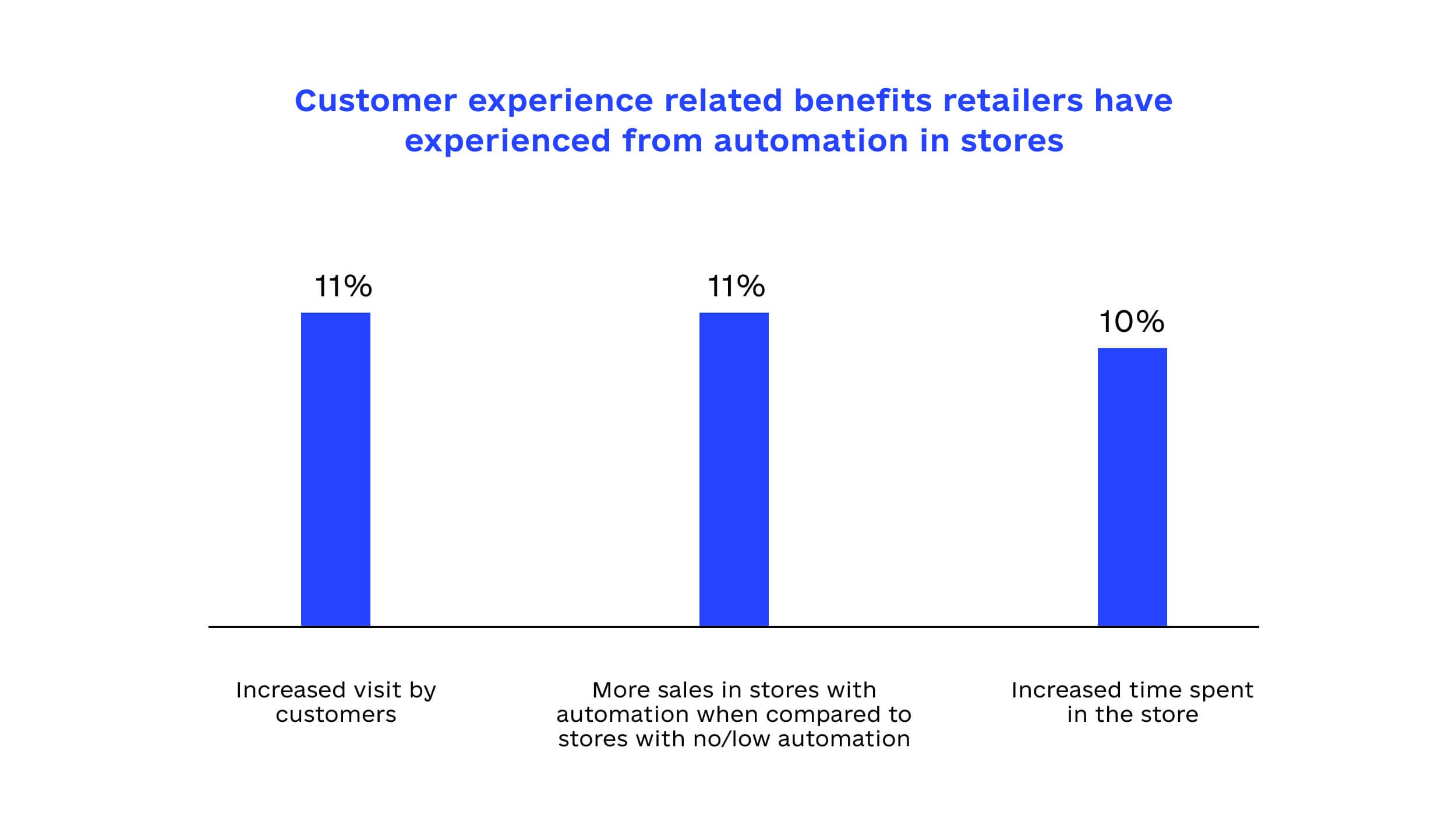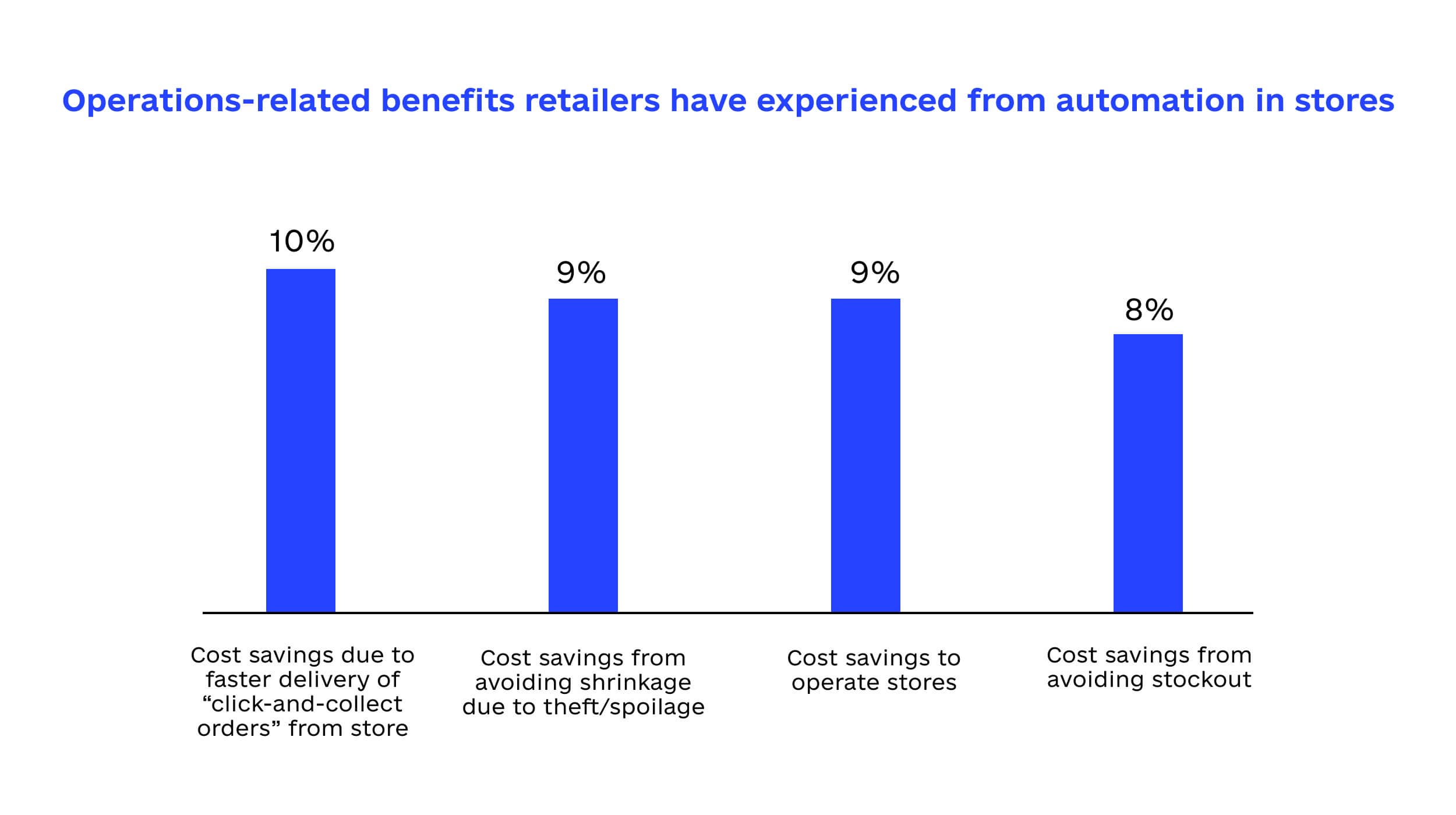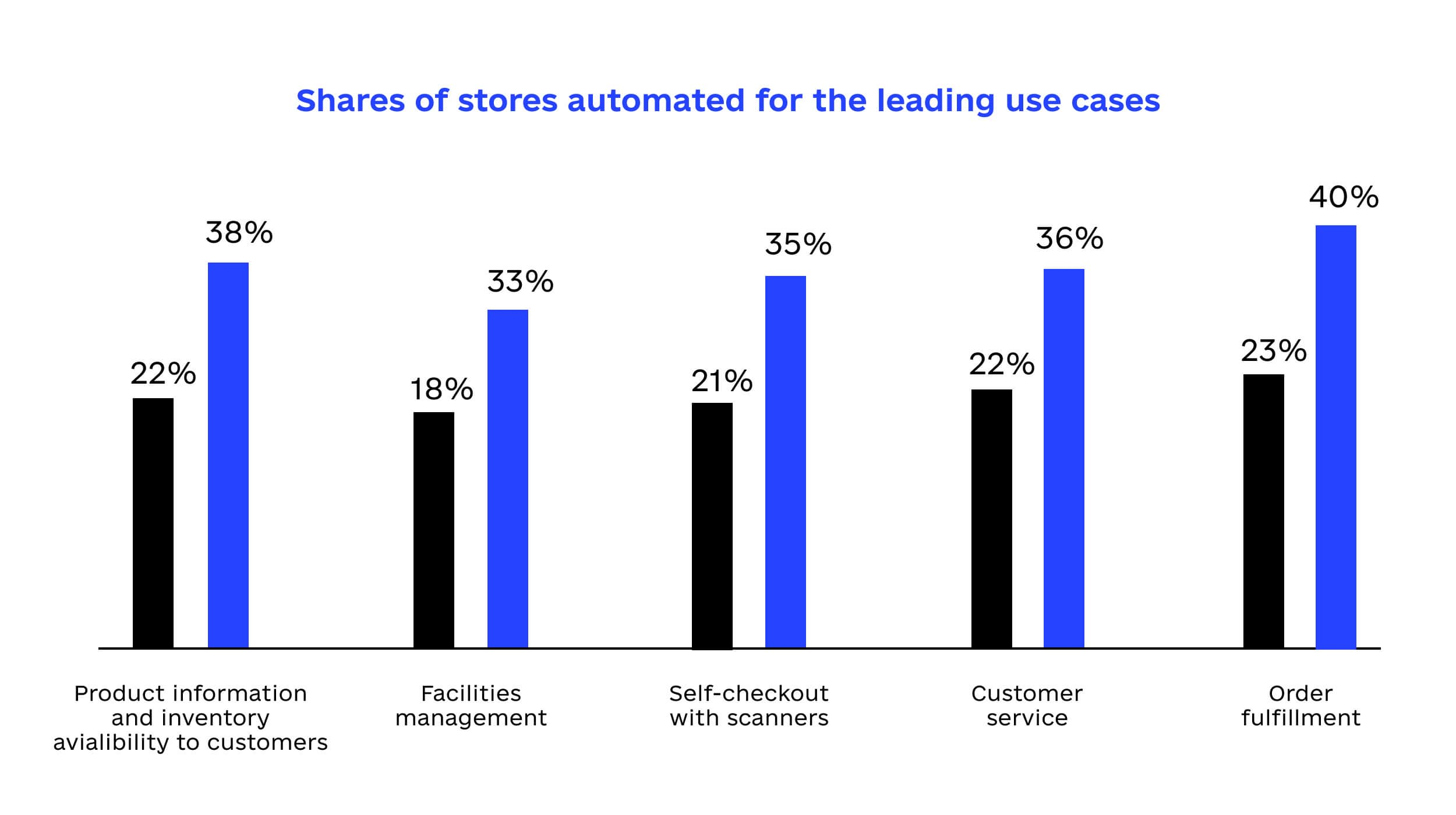Retail technologies are transforming the way stores, warehouses, and distribution centers operate by making everything more efficient. Just to give you an idea, back in 2020, the global retail automation market was valued at 11.3 billion dollars. And you know what’s more interesting? Statista says it’s set to triple by 2030, reaching 33 billion dollars! In this ever-changing retail landscape, staying on top of trends is more vital than ever.

Retailers are juggling a myriad of challenges, like soaring costs, mercurial customer expectations, and ruthless competition, all while adjusting to a post-COVID world. To remain a contender, businesses must cozy up to innovation and make the most of cutting-edge technologies. Retail automation is a goldmine of opportunities for you to reinvent and refine your operations.
Picture having several systems, such as point-of-sale, customer relationship management, and inventory management, that simply won’t get along. This communication breakdown can lead to inefficiencies, blunders, and misunderstandings that ultimately damage customer satisfaction and sales. An enterprise resource planning (ERP) system steps in to unite these functions, streamlining processes and turbocharging efficiency. While the advantages of retail automation are glaringly apparent, you might still face some obstacles when implementing the solution.
In this post, we’ll dive into the delights of retail automation, dissect the challenges retailers might encounter when embracing automation technologies, and share nifty solutions and best practices to help retailers overcome these barriers and fully tap into automation’s potential. Stay tuned for case studies, tips, and expert insights on how to elevate your retail operations through automation.
Table of Contents
- 1 Retail Automation Demystified: How Tech is Revolutionizing the Industry
- 2 6 Must-Know Benefits of Retail Automation for Business Success
- 3 Embracing Retail Automation: Strategies and Solutions
- 4 Retail Automation at Work: Examples Across Industries
- 5 The Retail Automation Adventure: 6 Steps to a Smarter Business
- 6 Potential Risks of Retail Automation
- 7 Conclusion
Retail Automation Demystified: How Tech is Revolutionizing the Industry
Retail automation – you’ve probably heard the term, but what does it really mean? Simply put, retail automation is all about using technology and machines to automate and streamline various processes within the retail landscape. This spans from inventory management and checkout to customer service and marketing. Thanks to the COVID-19 pandemic, retail automation has become more widely used, with retailers rapidly adopting technologies like contactless payment systems and automated order fulfillment to meet evolving customer demands.
From Guesswork to Precision: AI-Powered Predictive Analytics
Retail automation has come a long way since the rise of e-commerce and the increasing availability of advanced technologies like artificial intelligence (AI) and robotics has ignited a new wave of automation in the retail world.
In the past, retailers used historical sales data and manual forecasting methods to predict future demand and adjust inventory levels. The process was often slow and prone to inaccuracies, leading to stock shortages or overstocking of certain products.
Now, AI-powered predictive analytics has stepped in to save the day. Retailers can analyze vast amounts of data from various sources in real-time to make more accurate predictions about future demand. For instance, machine learning algorithms can scrutinize sales data, customer browsing behavior, and even social media trends to identify emerging demand for specific products. This empowers retailers to adjust inventory levels and ordering patterns, ensuring they have the right products in stock at the right time.
This shift has significantly improved inventory management, reducing stockouts and overstocking, enhancing product availability, and boosting sales.
Core Components of Retail Automation Systems
Retail automation systems are designed to improve business efficiency by using a range of interconnected components. Let’s dive into the main components that make up a retail automation system:
Hardware: Sensors, Cameras, and Barcode Scanners
These devices collect valuable data by monitoring customer interactions, tracking inventory, and processing transactions. They serve as the backbone of any retail automation system, capturing real-time information to help optimize various retail processes.
Point-of-Sale (POS) Systems
POS systems handle transactions and streamline the checkout process, making it easier for customers to make their purchases. These systems can also manage customer data, track sales, and integrate with other components like inventory management software.
Inventory Management Software
This software helps retailers monitor stock levels, automate restocking, and identify trends that impact inventory management. It’s crucial for ensuring the right products are available when customers need them and for minimizing overstocking or stockouts.
AI Algorithms: Analyzing Data for Insights
Harnessing the power of artificial intelligence, these algorithms analyze data gathered by other components to offer insights that drive improvements in customer experience, inventory management, and marketing strategies.
Robotics: Streamlining Order Fulfillment
Robots play a significant role in automating tasks such as picking, packing, and shipping orders, increasing efficiency and accuracy in the order fulfillment process. This results in faster delivery times and enhanced customer satisfaction.
6 Must-Know Benefits of Retail Automation for Business Success
Eager to take your retail enterprise to the next level? Discover six powerful benefits of retail automation that can streamline operations, satisfy customers, and skyrocket success.
Enhanced Customer Experience

Retail automation can significantly improve your customers’ overall shopping experience. By leveraging advanced technologies such as self-checkout kiosks, mobile apps, and interactive displays, you can deliver a seamless and engaging experience for your customers. This not only helps in retaining existing clients, but also attracts new ones, resulting in increased sales and customer satisfaction.
Easy Inventory Management
Keeping track of inventory in real-time can be a daunting task, but retail automation simplifies this process. With the help of automated inventory management systems, you can accurately track stock levels, preventing stockouts or overstocking. Additionally, these systems can provide you with valuable insights, such as identifying slow-moving items, enabling you to make data-driven decisions for better inventory planning.
Streamlined Checkout Process
Long queues at the checkout counter can frustrate customers and lead to lost sales. Retail automation can help streamline this process with technologies like self-checkout kiosks, mobile payment solutions, and contactless payment options. These innovative solutions not only minimize waiting time, but also provide customers with a more convenient and efficient shopping experience.
Reduced Labor Costs

Automating retail processes can reduce the need for manual labor, ultimately lowering labor costs. Technologies such as automated shelf-scanning robots, self-checkout kiosks, and AI-powered chatbots can handle repetitive tasks, allowing your employees to focus on higher-value activities like customer service and upselling. This leads to improved operational efficiency and cost savings for your business.
Data-Driven Decision Making
Retail automation provides valuable insights into customer behavior, sales trends, and inventory levels through data analysis. By harnessing this information, you can make informed decisions to optimize pricing, promotions, and product assortment. Moreover, data-driven decision-making enables you to identify areas of improvement and capitalize on new opportunities, driving business growth.
Minimized Human Error
Mistakes are inevitable when humans handle retail processes, but automation can significantly reduce the chances of error. Automated systems ensure accuracy in tasks like inventory management, price changes, and checkout processes. By minimizing human error, you can enhance efficiency, maintain customer trust, and avoid costly mistakes that could harm your business.
Embracing Retail Automation: Strategies and Solutions
Ready to overcome the challenges of retail automation adoption? Here’s how executives and retailers are addressing the most common obstacles and unlocking the full potential of automation:
Cost
One of the biggest barriers to automation adoption in retail has been the high cost of implementing new technologies. To tackle this, retailers are exploring alternative financing models, such as leasing, and collaborating with technology providers to share costs.
Resistance to Change
Another challenge is employees’ resistance to change, who may worry about job loss or feel intimidated by new technologies. Retailers are emphasizing the benefits of automation for employees, like increased efficiency and job satisfaction, while providing training and support to help them adapt to new systems.
Integration with Existing Systems
Many retailers have legacy systems and processes, making it difficult to integrate new automation technologies. They’re working with technology providers to develop customized solutions that can integrate with existing systems or adopting modular systems that can be added to current infrastructure.
Data Management
Automation technologies generate vast amounts of data, and retailers may struggle to manage and analyze this data effectively. To solve this, they’re investing in data analytics and visualization tools, as well as partnering with technology providers to develop tailored data management solutions.
Cybersecurity
Automation technologies can pose security risks if not implemented and managed properly, especially concerning customer data. Retailers are implementing robust cybersecurity protocols like encryption and access controls, and working with technology providers to ensure their systems are secure and compliant with industry standards.
Retail Automation at Work: Examples Across Industries
Here are some interesting cases of innovation, showcasing how businesses have harnessed the power of technology to overcome obstacles and achieve success.

Reporting: Automated Inventory Management
The Drama: A retailer was juggling inventory across multiple locations, frequently missing out on sales due to popular products vanishing off the shelves.
The Hero: Enter an AI-powered inventory management system, diligently monitoring stock levels in real-time and auto-ordering when supplies ran low. The result? Fewer stockouts, improved product availability, and a sales boost!
Fashion: Predictive Analytics
The Fashion Fiasco: A fashion retailer struggled to forecast demand for certain products, leading to overstocked items gathering dust and others selling out too soon.
The Stylish Solution: A machine learning algorithm strutted in, analyzing customer data and predicting future trends. The retailer could then adjust inventory and ordering, keeping the right products in stock at the right time, and ultimately improving sales and profits.
Retail: Personalized Recommendations
The Retailer’s Dilemma: Personalized product recommendations eluded a retailer, leading to sagging sales and disappointed customers.
The AI Alchemist: An AI algorithm whipped up personalized product recommendations by analyzing customer purchase history and browsing behavior. The result? Enhanced customer experience, increased sales, and loyal shoppers.
Customer Service: Chatbots and Virtual Assistants
The 24/7 Support Struggle: A retailer strained to offer round-the-clock customer support, drowning in a sea of calls and emails.
The Chatbot Cavalry: Chatbots and virtual assistants swooped in, providing instant support and answering common questions. Human customer service agents sighed with relief, and customers enjoyed a smoother experience.
Ecommerce: Robotics for Order Fulfillment
The Online Order Overwhelm: A retailer buckled under the pressure of online orders, dealing with delays and errors in the fulfillment process.
The Robotic Reinforcements: Robots rolled in to automate the order fulfillment process, from picking and packing to sorting and delivering. Efficiency and accuracy soared, delivery times shrank, and customer satisfaction climbed to new heights.
The Retail Automation Adventure: 6 Steps to a Smarter Business
With these six insightful steps, designed to guide you through the process of transforming your business into a more efficient, customer-focused, and tech-savvy operation.

Step 1: Identifying Your Automation Targets
Before diving into the world of retail automation, take a step back and evaluate which areas of your business could genuinely benefit from a tech upgrade. It could be inventory management, order fulfillment, customer service, or marketing—pinpointing these areas will guide you in the right direction.
Step 2: Assess and Align Your Goals
To get the most out of your automation journey, you’ll need to have a clear understanding of the challenges you’re facing and the goals you want to achieve. Consult with your team and key stakeholders to get their input and create a well-rounded vision for automation. Are you looking to increase efficiency, cut costs, or improve customer experience? Identifying these objectives will help you stay focused.
Step 3: Picking the Perfect Tech Sidekick
Selecting the right automation technology is crucial. Compare various options, such as AI-powered inventory management systems or robotics for order fulfillment, by considering factors like cost, compatibility with your existing systems, and specific functionalities. Choose a tech partner that complements your business goals and overcomes its challenges.
Step 4: Crafting Your Implementation Master Plan
A well-thought-out implementation plan is the backbone of a successful automation venture. Develop a detailed timeline, budget, and strategy for employee training and support. You might even consider running a pilot program to test the waters before taking the full plunge into automation.
Step 5: Bringing Automation to Life
Collaborate with your technology provider to install and configure your new system, or train your employees on how to use and maintain it. Keep a watchful eye on the implementation process, addressing any issues that may arise and ensuring everything runs smoothly.
Step 6: Monitor, Optimize, and Evolve
Stay on top of your game by monitoring key performance indicators like sales, inventory levels, and customer satisfaction. Analyze the data to fine-tune your system and improve its effectiveness continually. Regularly revisit and update your automation strategy to adapt to your ever-evolving business landscape. Welcome to the future of retail!
Potential Risks of Retail Automation
While retail automation brings numerous benefits, it’s important to consider the potential risks that may arise during its implementation. Here’s an insightful look at some of these risks:
High Implementation Costs
One of the most significant challenges for smaller businesses when considering retail automation is the initial cost of adopting new technologies. It’s important to evaluate the return on investment (ROI) and determine if the long-term benefits outweigh the upfront expenses.
Job Displacement Concerns
As automation takes over certain tasks, there may be concerns about job displacement for employees. However, this can be mitigated by retraining and upskilling employees to take on new roles that focus on areas where human input is still essential, such as customer service and creative problem-solving.
Security and Cybersecurity Risks
Automating retail processes can introduce security risks, particularly when it comes to customer data protection. Retailers need to ensure that they have robust cybersecurity measures in place and work with technology providers to guarantee compliance with industry standards and regulations.
Integration Challenges
Integrating automation technologies with existing systems and processes can be complex and time-consuming. Retailers need to carefully plan for integration and work closely with technology providers to create customized solutions that can seamlessly fit into their current operations.
Conclusion
It’s essential to keep in mind that the real key to success in retail automation isn’t merely chasing after the newest fads. Instead, it’s about genuinely getting to know and adapting to the one-of-a-kind needs of both your business and customers.
As you continue to venture into the world of retail automation, remember that we’re always here to lend a helping hand or assist you in overcoming any challenges that come your way. We get that every business is unique, and that’s why our team of experts is committed to offering guidance and support, making sure your transition to automation is both seamless and effective.
















Popular
Latest